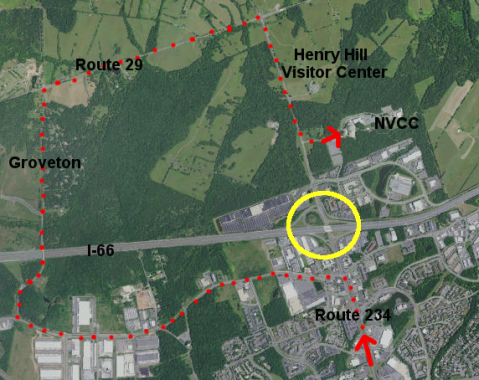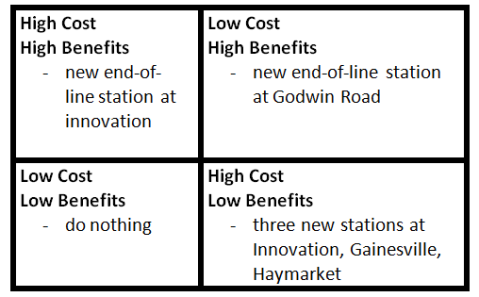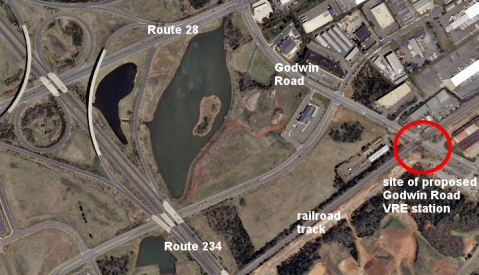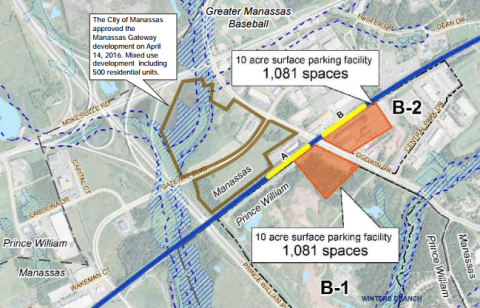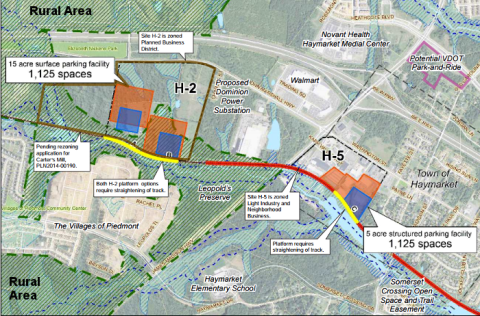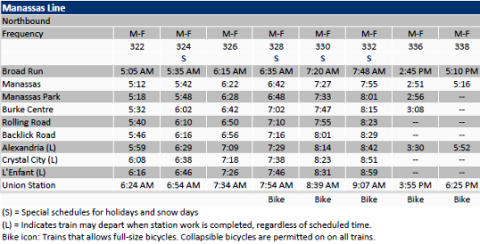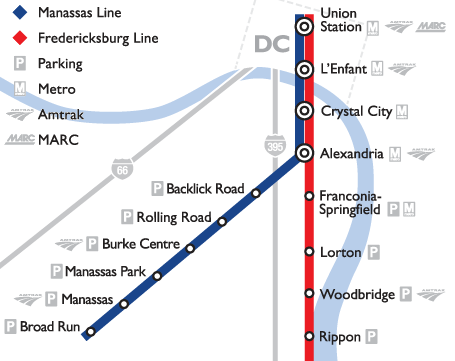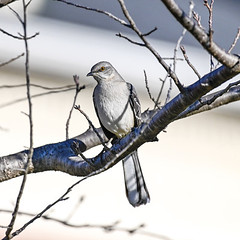Archive for the ‘Transportation’ Category
The Best Bypass to “Fix Route 28” Does Not Require Building A New Highway Through Bull Run Parkland
The traffic congestion on Route 28 is unacceptable, and the Route 28 Corridor Feasibility Study is underway.
The Northern Virginia Transportation Authority (NVTA) and Commonwealth Transportation Board are poised to fund widening Route 28 in Fairfax, creating new interchanges to eliminate stoplights – and potentially a brand new highway extending Godwin Road over Bull Run.
The new four-lane highway is the obvious preference of the Department of Transportation in Prince William County. The county’s transportation officials see more-bigger roads as the solution to every mobility problem, and endorse every highway that can be sketched on a map.
Their choice is Option 2B, extending Godwin Drive from Route 234 (Sudley Road) across Bull Run:
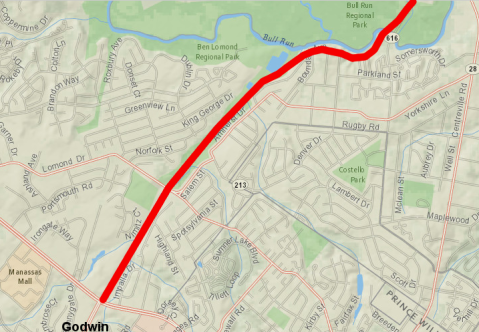
Option 2B, extending Godwin Road across Bull Run
County officials are not born with infinite wisdom and do not always have the right answer. In this case, they do not even have the right question. This is not a play written by Shakespeare, where “2B or not 2B, that is the question.”
Fortunately, the process to get Federal funding requires public involvement and the consideration of alternatives beyond the preferences of county staff. More lanes and fewer traffic lights are obviously part of the solution, but building a new road across Bull Run is not.
Best place to start before spending hundreds of millions on a new road: define the problem.
Two streams of traffic get clogged on Route 28:
1) vehicles going north from Manassas to I-66
2) vehicles coming up Route 28 from Fauquier County line that go through Manassas, and then join the congestion from Manassas to I-66
There are two separate solutions to those two problems.
Manassas to I-66
Widening Route 28 north of Bull Run in Fairfax where the corridor has been planned for more lanes, and eliminating stoplights with revised interchanges and overpasses, will speed traffic between Manassas and I-66 significantly.
South of Bull Run, the potential to widen Route 28 between Manassas-Yorkshire is limited by the number of commercial operations on either side of the road. Destroying businesses in Manassas/Manassas Park/Prince William, so commuters can drive to jobs in other jurisdictions, will not help the local tax base or local employment opportunities.
It may be feasible to re-engineer some of the frustrating interchanges in Manassas, Manassas Park, and Prince William to minimize the delay from stoplights.
From Fauquier County Headed North
The best way to get the traffic to bypass Manassas is… (drum roll, please) use the existing Route 234 Bypass to bypass Manassas.
Traffic coming north from Fauquier County can go 5 miles to reach I-66 via the Route 234 Bypass. That road is planned to be a 6-lane highway with overpasses between Route 28 and I-66.
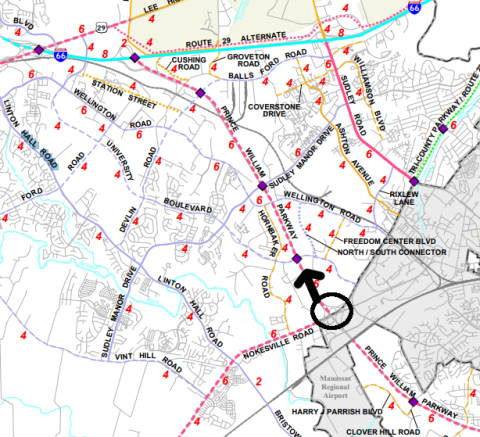
purple squares show planned overpasses from Route 28/234 Bypass (black circle) to I-66
Even if Option 2B was built to German autobahn standards, the 5-mile drive via Route 234 Bypass will always be quicker than the 9-mile drive via Route 28 at Centreville.
The goal is to get vehicles to I-66, right? Express Mobility Partners is spending $3 billion or so to upgrade that interstate to move traffic. Route 234 Bypass is a straight shot from Route 28 to I-66. In contrast, Option 2B would be a long, winding road. It would be slower for drivers, and waaaay more expensive for taxpayers.

traffic from south of Manassas can get to I-66 (blue dots) without clogging Route 28 in Fairfax County (yellow dots)
And why would we want to stick even more cars on Route 28 north of Bull Run?
With Option 2B, 8 lanes of traffic would have to squeeze into the 6-lane Route 28 corridor in Fairfax County. That would just create a new bottleneck and create more congestion on the route to Centreville.
Eliminating stoplights on the Route 234 Bypass will help make Innovation more attractive for development. The Innovation site is intended to be a place for businesses to bring jobs to Prince William, and to evolve into a live-work-play center – so let’s invest there.
We can divert traffic away from the chokepoint of downtown Manassas without building a new road across Bull Run. No houses, no wetlands, and no historic Civil War battlefields need to be destroyed by constructing Option 2B.

Bull Run, upstream of Mitchell’s Ford
When the environmental analysis of the “Fix Route 28” proposals gets serious, transportation planners will be confronted with Section 106 of the National Historic Preservation Act and Section 4f of the Department of Transportation Act of 1966.
Both require close examination of feasible alternatives before blasting new roads through parks. The Civil War Trust and NOVAParks have already made clear their objections.
The question is “how do we minimize future – as well as current – congestion.”
Option 2B is not the answer.
There is a clear alternative: improve the existing Route 234 bypass to bypass Manassas, rather than build a new highway cutting through neighborhoods, sensitive riparian areas, and the 1861 battlefield.
(Yes, more Virginia Railway Express service from Broad Run station could reduce future congestion as population grows, but that’s another blog post.)
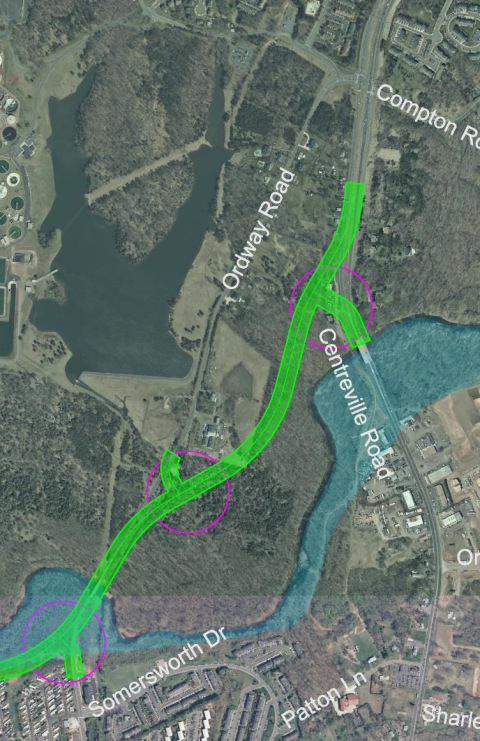
Option 2B cuts through Bull Run Regional Park
Community: 1, Buckland Bypass: 0
 The room at Haymarket Elementary was packed with 150+ people. A significant percentage wore T-shirts expressing opposition to the latest proposal for a Buckland Bypass,a 4-lane divided highway west of Haymarket. concerned that Prince William County was proposing (again) to build a Buckland Bypass.
The room at Haymarket Elementary was packed with 150+ people. A significant percentage wore T-shirts expressing opposition to the latest proposal for a Buckland Bypass,a 4-lane divided highway west of Haymarket. concerned that Prince William County was proposing (again) to build a Buckland Bypass.
Fauquier officials made clear that they did not support the Buckland Bypass (which would start in their county) now, and never have.
The residents of Cerro Gordo and nearby neighborhoods made their points clearly, politely, forcefully, and successfully last night. All but perhaps one were clearly opposed. The road would displace residents, transform the character of the neighborhoods, potentially dry up wells – and the costs would far exceed the benefits.
Jeanine Lawson, Brentsville District Supervisor, commented that they “killed it.” She predicted with confidence that there will be no Comprehensive Plan Amendment to initiate a Buckland Bypass.
Earlier in 2017, the county floated a proposal for a new highway linking Route 29 and I-66, so commuters driving north from Stafford, Culpeper, and Fauquier would be able to cut through Prince William’s Rural Area in order to get to work.

The county’s project was an echo of previous proposals for a Western Bypass or Outer Beltway. Various versions of new roads have been justified by the supposed need to get heavy trucks from I-95 to I-81 quicker, or to move commuters to the west before they drive eastward towards DC, or… well, pick a rationalization, they’re all equally valid.
The fundamental push has been from developers who want to by land cheap, get it rezoned to “bust” the Rural Area protections, and then build more subdivisions. If only the government would build new roads, then traffic congestion would simply evaporate. Then everyone would support more residential development on the periphery of the urban core, right?
Reality suggests otherwise. I-66 has been widened to Haymarket, and a new interchange completed. A new Route 29 interchange at Linton Hall has been built. That did not cause traffic to evaporate – and the “just build more roads; that will fix it this time” argument failed last night.
The Buckland Bypass was only a skirmish. It can be compared to the Buckland Races in 1863 – important for those directly affected, but not a conclusive engagement in the war. The real challenge, protecting the Rural Area, still lies ahead.
 proposed “short routes” discussed at the October 10 Stakeholder’s Meeting
proposed “short routes” discussed at the October 10 Stakeholder’s Meeting
VDOT Tries Sneak Attack – Again – for New Roads West of Haymarket
The Virginia Department of Transportation (VDOT) is engaged in another hide-and-seek exercise to facilitate sprawl west of Haymarket. They’re back, trying to build new roads west of Haymarket that are not in the county’s Comprehensive Plan.
The game plan is to use the massive “Transform I-66” project as an excuse to extend Heathcote Boulevard west, and build a bridge over I-66 connecting Heathcote to Route 55 near the Amazon data center.
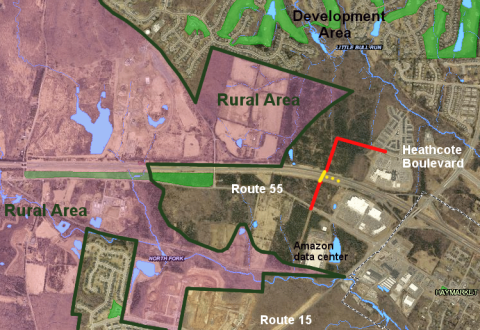
new roads are in red, and the new bridge with HOT ramps is in yellow
As they say on TV – but wait, there’s more. Prince William County has already restarted a study of another road, the developers’ dream known as the Buckland Bypass. It would run from Fauquier County north along the edge of the Bull Run Mountains.
If a 4-lane divided highway replaced Thoroughfare Road south of I-66, how long before there’s a proposal to widen Antioch Road and build a 4-lane road parallel to Route 15 at the base of Bull Run Mountain north to Loudoun County? It’s another flavor of the Bi-County Parkway nightmare.
Once again, VDOT is not being transparent or straight-up i n its Transform I-66 planning. The next round of I-66 public discussion, the Concept Plan meetings scheduled in June, has no discussion of any new construction west of Route 29.
n its Transform I-66 planning. The next round of I-66 public discussion, the Concept Plan meetings scheduled in June, has no discussion of any new construction west of Route 29.
The VDOT public involvement process is “Hey folks, look this way, to the east… no no no, don’t look at what we’re planning west of Route 29 until it’s too late to change anything.”
VDOT’s Concept Plan public meetings in June resemble the way magicians do something flashy to draw the audience’s attention to one side of the stage, while stuffing a rabbit into the hat.
This is not VDOT’s first magician show on expanding roads west of Route 15. In 2015, after finishing all the public events to discuss how to improve I-66, the state transportation agency tried to sneak into the plan a new parking lot on Antioch Road, replacing an operating local farm with pavement.
The public response, including a resolution by the Board of County Supervisors to save the Heflin Farm, was quick and loud. The parking lot was dropped before the I-66 project was approved by the Virginia Commonwealth Transportation Board (CTB).
Now it’s back, though hidden quite well. You have until midnight, April 8 to submit your comments on this latest attempt. Yup, the deadline is that tight.
Continue reading
Buckland/Haymarket Bypass: Just Moving a Pawn in the Bi-County Parkway Chess Game
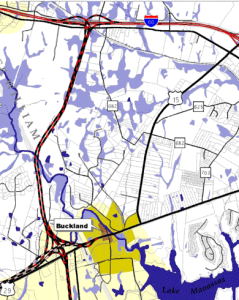 Prince William County is considering constructing a new road between Route 29 and I-66, cutting through the Rural Area west of Haymarket.
Prince William County is considering constructing a new road between Route 29 and I-66, cutting through the Rural Area west of Haymarket.
The latest Buckland/Haymarket Bypass proposal is not a new idea. It’s a vampire that just won’t die, and continues to suck planning resources.
The latest (2016) proposal is to build a 4-lane divided highway with a 40-wide median in the center. The road would be designed for cars to go 55-60mph between the county border and a new I-66 interchange.
There would be no intersections for any connections to local roads, not even Route 55 (John Marshall Highway). Drivers would bypass every business in Prince William County, so the local economic development score is… zero, zip, nada.
Three lines have been drawn on the map as alternative routes for the county’s planning process. On January 26 the county’s Department of Transportation hosted a “stakeholder’s” meeting to discuss which route might be preferred.
The answer was a clear “none of the above.”
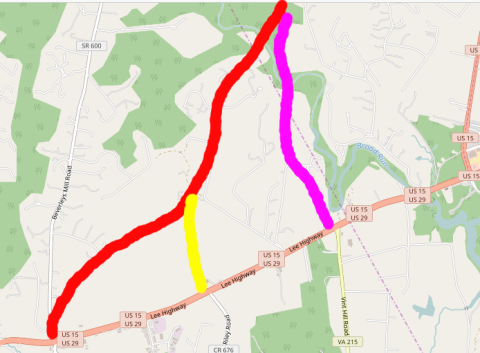
The only options proposed by Prince William County were
three routes for a new road and “do nothing.”
Fauquier County supervisor Holder Trumbo made clear at the start of the meeting that his county’s officials were strongly opposed to constructing a new bypass, and he did not expect the Prince William planning process to alter that perspective.
Members of the public also did not buy what Prince William staff were selling.
During the discussion, staff suggested that there were concerns:
(1) cumulative impacts on the Buckland Historic District,
(2) a need to accommodate traffic coming up Route 29 from North Carolina, and
(3) growing commuter traffic coming from south of the Prince William-Fauquier boundary.
Stakeholders questioned how the county had already decided that a new road was the best solution to those problems.
The public challenged county staff to consider more alternatives, such as improving Route 29 sight lines and removing stoplights – particularly at the Vint Hill Road/Route 29 interchange. Speakers also noted that the recent investment of $1 billion in new highway construction, to improve the Route 29/Linton Hall interchange and widen I-66, had reduced traffic congestion significantly.
So why was the Buckland/Haymarket Bypass being discussed at all? Ah, that’s the interesting part of the story.
Continue reading
Will VRE Capacity Grow – or Be Frozen?
 The Virginia Railway Express (VRE), Northern Virginia’s commuter rail system, just lost its gamble.
The Virginia Railway Express (VRE), Northern Virginia’s commuter rail system, just lost its gamble.
The proposed construction of 11 miles of new track and three new stations at Innovation, Gainesville, and Haymarket is not cost effective. This week, local officials are expected to reject the expansion plans because they require too much money for too few benefits.
Local officials could go one step further and freeze any plans for adding capacity to VRE.
The study assumed three new trains would be added in the morning and evening rush hours to carry more commuters.
If the Board of County Supervisors in Prince William approves on December 13 the resolution proposed by staff, VRE’s ability to add those three new trains could be killed along with the proposed construction to Haymarket.
Ugh. VRE bet the house on the Gainesville-Haymarket Extension Study, but now could lose the entire farm.
Phase I of the study has revealed that constructing new track/stations would cost up to $660 million, and would not be competitive for Federal grants. The state, Northern Virginia Transportation Authority (NVTA), and local governments would have to dig deep, really deep into their pockets for one-time capital costs exceeding half-a-billion dollars.
Not likely.
Even worse, the study revealed that if the extension were built, annual operating costs would skyrocket and require more local subsidies every year. Local jurisdictions pay for 50% of the costs for each train trip; fares purchased by passengers covers only half the cost of each ride.
Finding more money for VRE operations, every year, would require local officials to cut funding for something else, every year.
Not likely, especially as Metrorail’s funding crisis squeezes NVTA jurisdictions such as Fairfax County..
If the benefits were worth the cost, then increased VRE subsidies make sense. After all, commuter rail reduces traffic congestion at rush hour. As I-66 tolls go into place, more commuters will consider VRE as an alternative route to work.
However, building new track to Haymarket would add only 555 new round-trip passengers each day. Compared to just adding three new trains on the existing track, the Haymarket extension would cost $9 million more in operating costs.
That’s over $16,000 per person, each year. Double ugh.
The surprise result in the Gainesville-Haymarket Extension Study was that one option was feasible. Moving the current Broad Run station north to Godwin Road, and expanding the railyard and maintenance facilities now at Broad Run, would allow VRE to run three additional trains at morning and evening rush hour. The “Broad Run Relocated” option, with additional trains and railyard expansion, was far more cost-effective than any option involving construction of new track and new stations west of Route 28.
However, the high costs of the extension proposal led to county staff proposing a “none of the above” alternative. Staff’s resolution for the December 13 meeting of the Board of County Supervisors is to do nothing, and simply terminate any study.
The staff’s resolution could block future VRE growth. Without expansion of the Broad Run railyard, there would not be space to park and service additional trains. VRE might add cars to current trains to mitigate current crowding, but capacity would be capped.
Not coincidentally, killing VRE expansion would provide the county’s transportation department with more funds for new road construction. The “build more roads, forget about transit” mentality is always a factor in Prince William.
The Board of County Supervisors could recommend that the Gainesville-Haymarket Extension Study proceed to Phase II, and scope Phase II to consider only the Broad Run Relocated option. Or it could terminate VRE expansion plans with extreme prejudice…

proposed expansion of Broad Run railyard
How Many Cars Would VRE Extension to Gainesville-Haymarket Remove From I-66? You Do the Math
 VRE responded to the blog post VRE Extension to Haymarket Proposes to Remove 100 Cars/Day from I-66… At Cost of $468 Million.
VRE responded to the blog post VRE Extension to Haymarket Proposes to Remove 100 Cars/Day from I-66… At Cost of $468 Million.
They said:
“The statement that the extension alternative ‘only removes 100 more cars’ compared to the enhanced Broad Run alternative is not correct and is not based on the information presented by VRE. There was discussion during the public meeting of projected ridership and related savings in automobile vehicle miles traveled, or VMT. The 2025 ridership estimates presented for the Manassas Line show a difference of 600 riders for a Broad Run terminus (13,200) versus a Haymarket terminus (13,800). The Haymarket extension alternative would save corridor commuters 88,600 daily VMT, while the Broad Run alternative would save 31,300 VMT.”
True, VRE did not provide the 100 cars/day number at the public meetings – but that 100 cars/day number is based on the information presented by VRE.
To help you do the math on your own without waiting for VRE to unveil this key statistic:
– 600 riders equals 300 cars in the morning and 300 cars in the evening, if everyone drives alone.
– 600 riders equals 100 cars in the morning and 100 cars in the evening, if each is carrying three people to avoid the toll after I-66 is “improved” with new toll lanes.
VRE’s numbers about Vehicle Miles Traveled (VMT) are not the same as the number of cars/day. Do not confuse the VMT numbers with the number of cars removed from I-66.
The VMT numbers do provide some insight. One car going from Gainesville to DC travels about 34 miles inbound and 34 miles coming home, or 68 VMT per day. The difference between retaining the existing Broad Run station vs. building three stations to Haymarket would be 55,300VMT/day, counting both inbound-in-the-morning and outbound-in-the-afternoon travel.
At 68 VMT per vehicle per day, assuming everyone drove solo and paid the tolls required to travel on I-66 inside the Beltway, that equals 55,300VMT/68VMT per day. That would be 813 cars/day.
If drivers chose to avoid tolls and carried two passengers, the the HOV3 number would be 813/3 or 271 cars/day.
VRE is an effective way to move commuters from the periphery into the urban core. According to VRE’s presentation at the April 27 community meeting, each train carries 1,000 passengers and each lane of I-66 carries 2,000 vehicles/hour. (Each car carries about 100 passengers, so VRE’s numbers assume 10-car trains.)
If the four VRE trains leaving Broad Run between 6:15am and 7:48am were completely full, They would reduce congestion on I-66 during that 90-minute period by 4,000 passengers. That would be equivalent to 1,333 cars if each carried 3 people, or 4,000 cars if everyone was driving solo, or about 75 OmniRide buses.
The overall VRE system itself is an effective way to transport commuters. It is the proposed extension to Gainesville-Haymarket that fails the cost-effectiveness test. At $468 million to remove 100, 271, or even 813 cars/day… surely there is a better way to spend the taxes raised by the 2013 General Assembly to reduce traffic congestion.
What Should Be the “Locally Preferred Alternative” for Expanding Service on the VRE?
 The Virginia Railway Express (VRE) proposed expansion to Gainesville/Haymarket requires an Environmental Impact Statement (EIS) to analyze the alternatives. (NOTE: VRE has responded to this post, asking for an update because: “A determination has not been made as to the federal environmental review process required under the National Environmental Policy Act (NEPA). VRE is working with the Federal Transit Administration to determine the federally required NEPA class of action.“)
The Virginia Railway Express (VRE) proposed expansion to Gainesville/Haymarket requires an Environmental Impact Statement (EIS) to analyze the alternatives. (NOTE: VRE has responded to this post, asking for an update because: “A determination has not been made as to the federal environmental review process required under the National Environmental Policy Act (NEPA). VRE is working with the Federal Transit Administration to determine the federally required NEPA class of action.“)
VRE announced at its Community Meeting on April 17, 2016 that it hoped to identify a Locally Preferred Alternative *before* that analysis is completed.
Asking local officials to choose one alternative, without knowing the benefits/costs of the different choices, is a premature, “leap before you look” approach.
An EIS is not intended to justify a pre-determined choice. Failure to complete an honest assessment of all reasonable choices could put at risk VRE’s hopes to get Federal funding. One reason the Bi-County Parkway project never received Federal approval was debate over whether a key alternative had been included in the EIS process.
(NOTE: VRE also responded with “It is not uncommon for projects to identify an LPA before starting the Federal environmental review process; that decision can also be deferred until the environmental review process is underway. To inform the decision on the LPA, VRE will continue to develop more detailed information regarding the smaller subset of alternatives presented at the April community meeting, including service plans and station locations.” That would suggest there is no plan to analyze one obvious alternative discussed below: build an end-of-line station at Innovation)
If local officials proceeded anyway, what should they chose?
“Do nothing” is an option, but a poor one. Northern Virginia has a great opportunity now to convert VRE from a commuter rail system, running only a few trips a day during rush hours, into a transit system that would offer regular service throughout the day.
The best way to stimulate local jobs, reducing the need to commute and reducing traffic congestion over time, is to enhance the transportation link between Manassas Park/Manassas/Prince William . If VRE expanded service to become a transit system, employers could locate offices near VRE stations and recruit skilled workers from the urban core as well as from subdivisions south of the Occoquan River.
All other choices in the future EIS will probably include increasing the number of trains from the current eight (8) in the morning to eleven (11) in the morning, and increasing the number of trains returning home by the same number.
The option being advertised most heavily by VRE is to build three new train stations at Innovation. Gainesville, and Haymarket, plus additional lines of track and a new railyard.
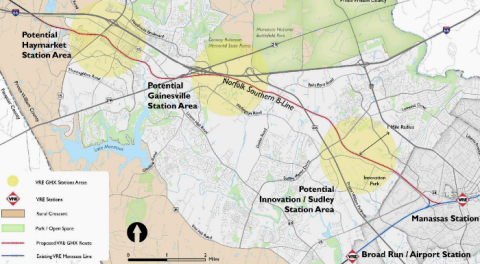
That would be the most expensive choice. It was priced at $468 million when submitted to the Commonwealth Transportation Board in 2016. The net benefit of that big investment is small, however. In 2025 it would remove only 100 more cars/day from I-66, compared to the “stay at Broad Run and add three new trains there” option.
Even before completion of all the analysis for the EIS, it is clear that two other choices offer more benefits at lower cost. Both include building just one new station, which would obviously be less expensive than building three new stations.
The best combination of low costs/high benefits appears to be the option of building a new end-of-line station at Godwin Road. Replacing the current Broad Run station with an expanded railyard for maintenance/train storage would allow VRE to add the additional trains already planned.
(An expanded railyard is required for VRE to evolve into a transit system with hourly service to Alexandria. Using the existing facilities at Broad Run obviously would be far less expensive than buying 25 acres and building a brand new railyard west of Haymarket.)
Moving the end-of-line station 1.5 miles north to Godwin Road offers the greatest opportunity to increase economic benefits from transit-oriented development. Broad Run is under the flight path for Manassas Airport, but the City of Manassas has already planned for a “gateway” to the city with new development at Godwin Road.
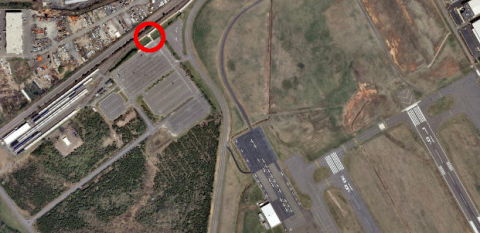 Broad Run Station is too close to the airport flight path
Broad Run Station is too close to the airport flight path
to allow transit-oriented development
One other option could be a competitor for “locally preferred alternative.” The end-of-line station could be moved to Innovation, where Prince William County is seeking to create a job center with a mix of housing and office buildings, the George Mason University Science and Technology campus, and the Hylton Performing Arts Center.
Annual operating costs at Innovation would be higher that building an end-of-line station at Godwin Road. Trains based at Broad Run would have to travel further at the start/end of day, and payments to CSX Railroad for using their tracks would be higher.
Changing the VRE Manassas Line: Exploring the Godwin Road Station Alternative
The Virginia Railway Express (VRE) is exploring if it should extend the line that runs from Broad Run through Manassas to Union Station, as well as add three new trains to carry commuters into DC each morning.
The “full bore” expansion option is to build new stations at Innovation, Gainesville, and Haymarket, while closing the existing Broad Run station and the end of the Manassas Line That would require adding a second (and potentially a third) railroad track for the 11 miles to Haymarket, plus construction of a new railyard west of that town.
Compared to the “minimal change” alternative of adding the three new trains but maintaining the existing station at Broad Run, constructing a new 11-mile extension to Haymarket would cost an additional $250-$350 million. Despite the expense for the additional infrastructure, VRE would carry only an additional 300 daily commuters each way in 2025 compared to the “minimal change” alternative.
Adding additional trains but still using the Broad Run station would provide a better benefit/cost ratio than the alternative of building three new stations, new tracks, and a new railyard near Haymarket. However, retaining the Broad Run station would create a major problem with train storage.
The railyard at Broad Run is limited in size. The current passenger platform blocks addition of the extra storage tracks that would be necessary, if VRE added three additional trains in each direction.
A third alternative, costing perhaps $10 million more than the “minimal change” option, is to build a new station where the railroad crosses Godwin Road in Manassas.
Godwin Road would become the end-of-line station and the platform at Broad Run would be closed. The Godwin Road alternative would allow expansion of the existing railyard.
It would cost far less to implement the Godwin Road alternative, compared to the high costs of building an extension to Haymarket with three new stations and a new railyard . A Godwin Road end-of-line station would also minimize annual operating costs, since the trains in the yard would be located just 1.5 miles away from the location where service starts/ends each day.
Most significantly, a station at Godwin Road is not underneath the flight path of Manassas Airport. Unlike Broad Run, the new end-of-line station could trigger transit-oriented development and create economic benefits consistent with the City of Manassas Comprehensive Plan.
The Manassas Landing area is described as a “gateway” for development. Placing a VRE station there could result in high-tech companies choosing to locate there. Adding more trains to VRE would offer the potential for skilled workers living within the urban core to commute to jobs in Manassas without using a car.
Planning for growth at Godwin Road provides a clear contrast to the planning by Prince William County for the land west of Haymarket. VRE has proposed a new station located west of Route 15, but at that site the station would be located within the Rural Area.
The Rural Area is supposed to be a zone of low density development. Unless current land use planning is ignored in order to speculate on rezonings that would transform the area, there would be few (if any) economic benefits for a new VRE station located west of Haymarket.
Additional Trains Coming on the Manassas Line… Will Transit-Oriented Development Follow?
The Virginia Railway Express (VRE) is planning to build three new stations and additional miles of track to extend commuter rail service to Haymarket. VRE plans to submit a request for Federal funding, and therefore must study alternatives as well as its preferred plan.
Built into almost all alternatives is an expansion of service. VRE currently operates 16 daily trains, eight inbound to Union Station in DC and eight returning home to the end of the line at Broad Run, next to Manassas Airport.
Between 5:00-8:00am on workdays, six morning trains with a capacity of about 100 people/rail car take commuters into DC. One mid-day train goes into Union Station at 2:45pm. One of the afternoon commuter trains returns into DC at 5:10pm to make a second run home at the end of the workday.
VRE is a commuter rail system, designed to carry passengers from Prince William, Manassas, and Manassas Park to jobs in the urban core in the morning and to bring those workers home each evening.
VRE is not a transit system like Metrorail. VRE shuts down on weekends and major holidays. VRE offers only one train going into DC in the late afternoon, and anyone using it would have to spend the night. There is no evening service that would allow passengers to take the train into DC for an event and then return.
The trains run on freight rail tracks owned by Norfolk Southern between Manassas and Alexandria, and owned by CSX between Alexandria and Union Station. The contract with CSX allows a maximum of 22 trains/day north of Alexandria.
CSX makes a profit running freight trains on those tracks. The private railroad company is reluctant to lease additional slots of time to VRE because the current two-track railroad bridge over the Potomac River is a major bottleneck. Until that bridge is replaced, VRE expects to be constrained to 22 daily trains north of Alexandria.
VRE offers only 16 trains carrying customers now, but uses all 22 slots allowed by CSX. Two slots are used to bring empty trains back from DC for storage, because the yard near Union Station is too crowded. VRE has “loaned” four slots/day to Amtrak, helping that long-distance passenger rail system and the state-supported regional rail version to offer additional service through Northern Virginia.
Whether or not VRE expands to Haymarket, the commuter rail system plans to add at least three trains in each direction. That would increase current commuter rail service from 16 to the maximum of 22 daily trains carrying passengers.
How will VRE gain six slots?
New track for train storage will be constructed near L’Enfant Plaza. The additional “parking spaces” for empty trains will allow VRE to convert the two slots used now to move empty trains so they carry paying passengers.
The four slots loaned to Amtrak will be reclaimed after new track is constructed on the Fredericksburg line. Relieving congestion there will benefit CSX’s freight rail operations as well as passenger rail operations. Amtrak will then negotiate for additional slots on its own, and release the four borrowed slots back to VRE.
Additional service will cost additional money. VRE will have to purchase additional locomotives and rail cars to offer the additional three trains daily into DC, and three more back. Federal and state grants may cover most or all of the one-time costs for capital equipment, but local governments will have to pay for the extra annual operations costs. The tickets purchased by passengers cover 50-55% of the cost of each trip, and local governments subsidize the remainder.
In addition to the three additional trains to carry commuters in the morning and evening, VRE is considering expanding service throughout the day, adding 14 more train trips.
VRE could run one train/hour on the Manassas Line between rush hours, with trains stopping in Alexandria. By stopping in Alexandria, VRE avoids the bridge bottleneck that blocks additional trains from going across the Potomac River.
Customers could switch to Metrorail at Alexandria. People living in the DC area could use Yellow/Blue Line trains to get to Alexandria, then catch VRE to get as far as Broad Run.
Adding train service every hour on workdays could have a long-term but dramatic effect on job creation in Manassas Park, Manassas, and Prince William County.
High-tech firms are reluctant to open an office on the periphery of the urban core, even though costs for space are lower and skilled workers are readily available (and potentially willing to demand less money, in order to eliminate the long commute to Tysons Corner, Arlington, or DC). The number of workers with a car and willing to commute outward to the edge of the urban region is limited.
If VRE offered consistent, reliable train access throughout the day, employers located south of the Occoquan River could tap into the pool of expertise, including the millenials with cybersecurity or other specialized training who have chosen to live “downtown.”
The best way to measure if that scenario is coming true will be to measure demand for office space within walking distance of a VRE station (about ¼ mile). Rents are at a premium near Metrorail stations. If the same pattern develops near VRE stations, then the additional train service could be credited with spurring Transit Oriented Development.
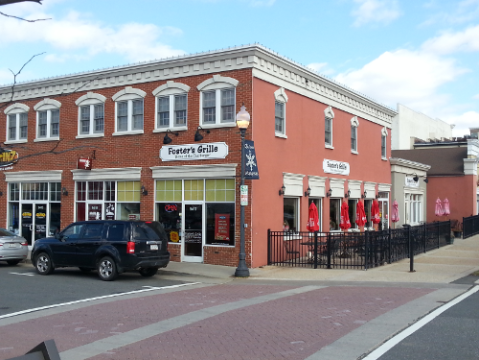 redevelopment of buildings next to the Manassas train station
redevelopment of buildings next to the Manassas train station
demonstrates the potential impact of converting VRE
from a commuter rail system into a transit system
 Comments (3)
Comments (3) VDOT advertises the $3 billion
VDOT advertises the $3 billion 